Welcome to a fruitful journey into the Philippines’ heart of Cavendish banana production. In this blog, we’ll explore the essential aspects of this thriving industry, delving into the farming practices that make it all possible.
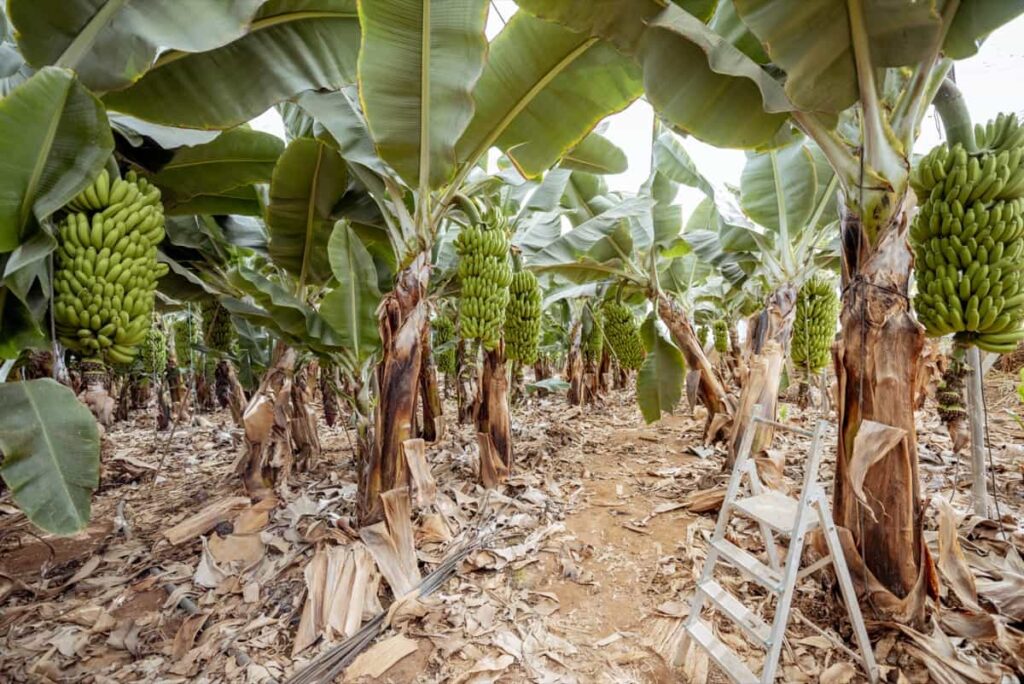
Prepare to uncover a world of cultivation techniques, environmental factors, and sustainable methods contributing to the nation’s position as a global banana powerhouse. Let’s peel back the layers and discover the captivating story behind the Philippines’ remarkable Cavendish banana production, where each step brings us closer to understanding its delicious success.
Introduction to Cavendish Banana Farming in the Philippines
Cavendish banana farming thrives in the Philippines, with extensive production areas nationwide. Over 80% of the country’s banana output comes from the Davao region, making it a vital hub. Other significant regions include Northern Mindanao, SOCCSKSARGEN, and Bukidnon. These areas benefit from suitable tropical climates and fertile soils, creating optimal conditions for Cavendish cultivation. The total land area dedicated to banana farming spans around 422,000 hectares, employing numerous local farmers.
The Philippines holds a notable position as one of the world’s top banana exporters, with millions of metric tons shipped annually. The industry plays a major role in the country’s economy, providing employment and contributing to foreign exchange earnings. Despite challenges like disease outbreaks and market fluctuations, the Philippines remains a formidable force in Cavendish banana production, solidifying its status as a key player in the global agricultural landscape.
Climate and Soil Requirements for Cavendish Banana Farming
Successful Cavendish banana farming hinges on specific climate and soil conditions, fostering optimal growth and yield. The preferred climate for Cavendish cultivation is tropical, with temperatures between 26 to 30°C (78 to 86°F) throughout the year. Bananas are sensitive to frost and extreme cold, hindering their development. The pH range of the soil should ideally be between 6 to 7, slightly acidic to neutral, ensuring proper nutrient absorption. Well-draining soils are crucial, preventing waterlogged conditions that can harm the roots.
In case you missed it: Banana Plant Care: Nutrients, Fertilization, and Protection from Pests and Diseases
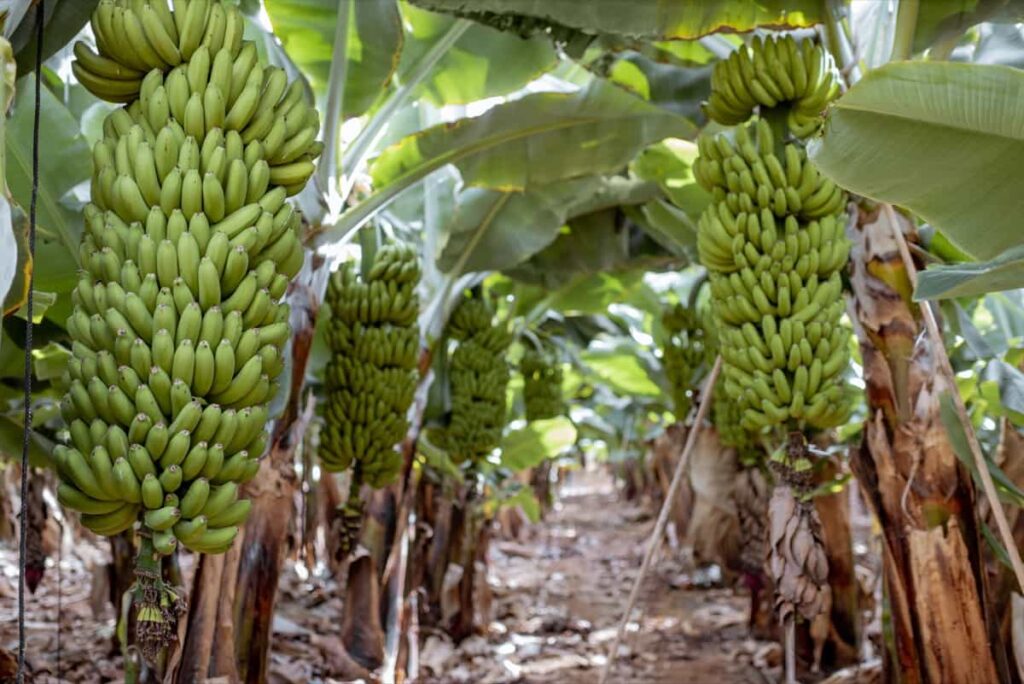
Regular irrigation is essential to maintain consistent moisture levels, especially during dry periods. Proper mulching helps retain soil moisture and suppress weed growth. A balanced fertilization regimen with adequate nitrogen, phosphorus, and potassium promotes healthy growth and robust fruiting. Soil management methods, such as crop rotation and cover cropping, aid in maintaining soil structure and fertility.
Selecting the Right Variety of Cavendish Banana for Farming in the Philippines
Selecting the right Cavendish banana variety is crucial for successful farming in the Philippines, where bananas dominate the agricultural landscape. Cavendish bananas contribute to about half of the nation’s total banana output and are cultivated across various scales, from backyard farming to large commercial plantations.
These bananas are mainly grown in Davao Region, Northern Mindanao, and SOCCKSARGEN, catering to domestic and international markets. Plantations often utilize tissue-cultured seedlings and adopt good agricultural practices (GAP) recommended by the Department of Agriculture.
The terrain is typically flat to hilly, with clay loam soil and effective drainage systems. The industry encompasses a range of scales: small, medium, and large commercial plantations managed by Filipino companies and multinational corporations. Cooperative efforts among growers support technical aspects and market access. While most exports are conventionally grown, a small share represents organic bananas, adding diversity to the export portfolio.
Land Preparation and Planting Techniques for Cavendish Banana Farming
Proper land preparation and planting techniques are vital for successful Cavendish banana farming. Regarding spacing, rows are typically 2.5 to 3 meters apart, while plants are placed about 2.5 meters within each row. This allows for adequate airflow and sunlight penetration, reducing disease risks. Planting holes should be around 40 cm deep and wide, enriched with organic matter and fertilizers. Usually, 8-10 months old, young plants are chosen for transplantation.
It’s recommended to avoid planting during heavy rains to prevent waterlogging. Before planting, the roots and pseudostems are trimmed to minimize water stress. To ensure stability, stakes are often placed to support the plants. Regular irrigation is essential, especially during dry periods. Mulching helps retain soil moisture and control weeds. Applying balanced fertilizers, especially potassium, is crucial for optimal growth.
Nutrient Management and Fertilization in Cavendish Banana Farms
Nutrient management and fertilization are crucial aspects of maintaining healthy Cavendish banana farms. Proper practices ensure optimal growth and yield. Initially, soil and leaf tests guide correct nutrition application during the first season. Fertigation is a favored method for accurate nutrient delivery throughout the plantation’s life cycle.
Well-maintained planting material can yield bunches within 12-18 months. Essential nutrients like nitrogen (100 kg/ha), phosphorus (60-90 kg/ha), and potassium (220 kg/ha) are typically applied in 6-8 doses annually. Disease-resistant planting material is recommended to prevent soil-borne issues. Adequate irrigation, mulching, and integrated pest management contribute to sustainability.
In case you missed it: Optimizing Banana Orchard Management: A Month-by-Month Maintenance Guide for Maximum Yield
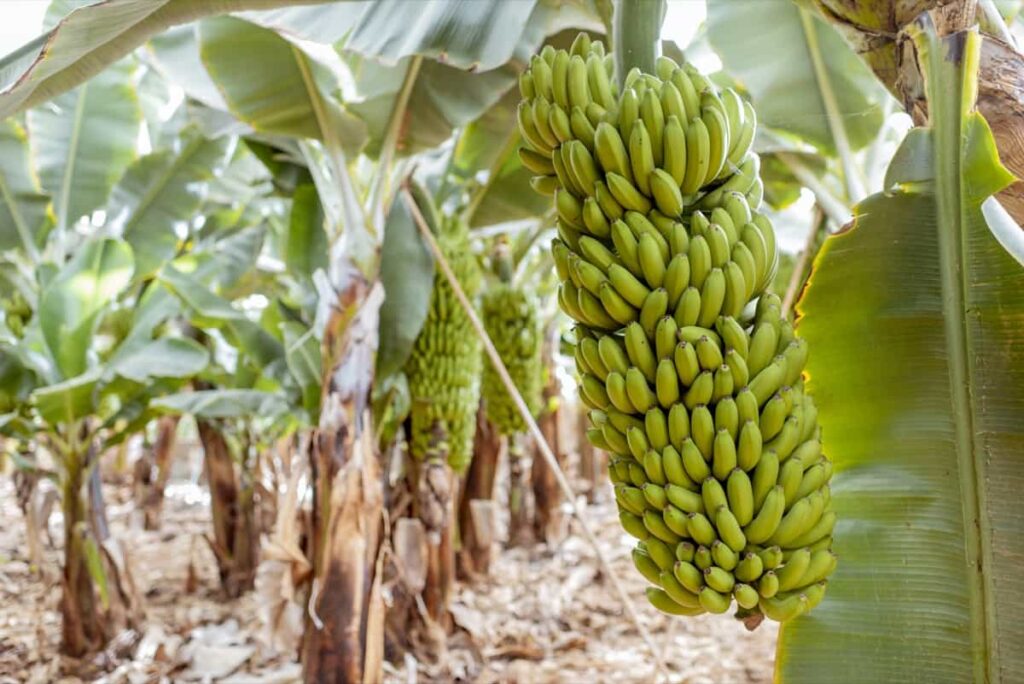
Desuckering controls competition and aids air circulation. To combat leaf diseases, timely removal of infected leaves is crucial. Ensuring healthy roots through weevil borer and nematode management is essential. Appropriate cover crops, like ryegrass or molasses grass, prevent soil erosion and weed competition.
Irrigation and Water Management in Cavendish Banana Farming
Proper practices ensure healthy plant growth and optimal fruit production. Regular irrigation is crucial to prevent water stress, especially during dry periods. Mulching helps retain soil moisture and control weed growth. Adequate drainage prevents waterlogging, which can damage root systems.
Tensiometers or similar devices monitor soil moisture levels, guiding irrigation decisions. Using efficient irrigation systems, such as drip or sprinkler systems, ensures uniform water distribution. Irrigation timing is essential, avoiding water application during heavy rain or when the soil is sufficiently moist. A balanced water supply fosters nutrient absorption and reduces the risk of disease.
Pest and Disease Control Strategies for Cavendish Banana Farms
Banana Bunchy Top Virus (BBTV) Management: BBTV, transmitted by the banana aphid, leads to bunched leaves and reduced fruit production. Using disease-free planting material and promptly removing infected plants to prevent virus spread. Promising resistant Lakatan lines are being studied at the Institute of Plant Breeding.
Banana Bract Mosaic Virus (BBrMV) Control: BBrMV, transmitted by aphids, causes mosaic patterns on bracts, leaves, and stems. Effective measures: Early detection, removal of infected plants, and insecticide application to reduce aphid populations. Focus on using disease-free planting materials for prevention.
Black Sigatoka Management: Caused by the fungus Mycosphaerella fijiensis, Black Sigatoka affects Cavendish plantations. Frequent aerial fungicide spraying, cultural practices (leaf removal, spacing, drainage), and managing costs.
Bacterial Wilt (Bugtok/Moko) Control: Bugtok, affecting cooking bananas, and Moko, impacting Cavendish, are caused by Pseudomonas solanacearum. Measures: Bagging inflorescences, early detection, eradication of infected plants, and controlled use of insecticides.
Fusarium Wilt (Tropical Race 4) Challenges: TR4, caused by Fusarium oxysporum f.sp. cubense is a lethal soil-borne fungus affecting Cavendish and other varieties. Strategy: Resistant cultivars, as chemical fungicides aren’t effective; focus on soil microbial community suppression. Widespread concern due to TR4’s soil survival, wide host range, and threat to global banana supply.
Importance of Resistant Varieties: Shifting to resistant varieties like Saba (resistant to Foc TR4) to mitigate Fusarium Wilt’s impact. Foc TR4 particularly threatens Cavendish cultivation, leading to production losses within months.
In case you missed it: Growing Banana Organically in Maharashtra: Cultivation Practices and Production Management
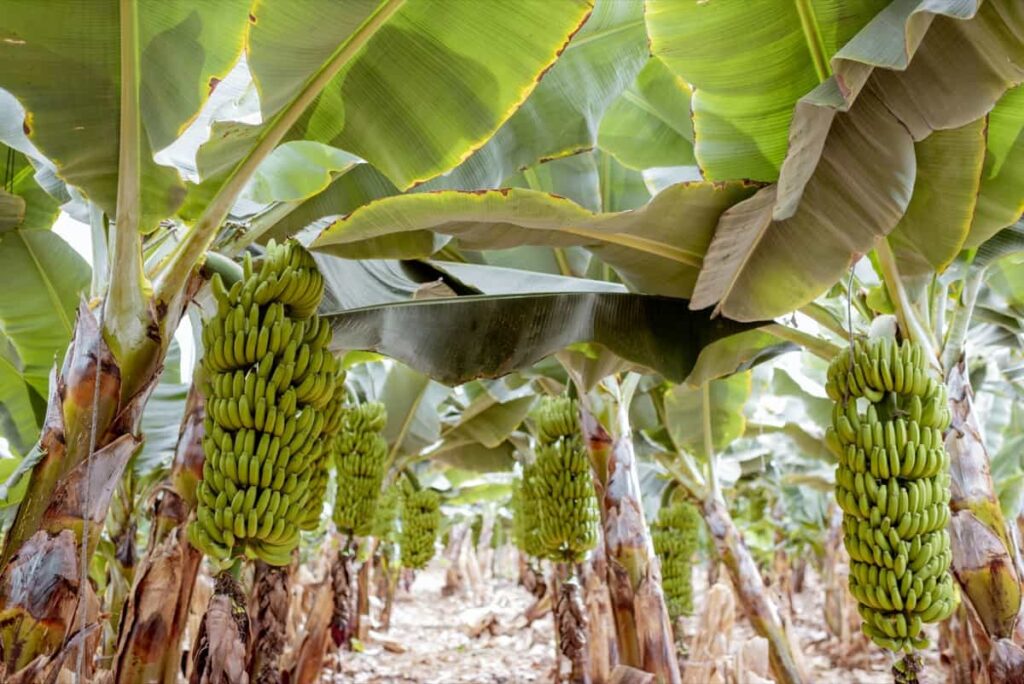
Weed Management in Cavendish Banana Plantations
Weeds compete with bananas for nutrients, water, and sunlight. Effective practices include regular cultivation or mulching to suppress weed growth. Spot spraying with non-systemic herbicides targets weeds without harming bananas. Care must be taken not to damage banana plants during herbicide application. Cover crops like ryegrass or molasses grass can also outcompete weeds.
Pruning and Canopy Management in Cavendish Banana Farms
Regular pruning involves removing old, damaged, or excess leaves, improving air circulation and sunlight penetration to the plant’s core. This promotes healthy growth and reduces disease risks. Managing the canopy ensures optimal fruit production by balancing vegetative growth and fruit-bearing. Other operations include desuckering, where unwanted shoots are removed, and proper irrigation and fertilization for sustained health and yield. These practices collectively enhance the overall productivity, quality, and longevity of the banana plantation.
Harvesting and Post-harvest Handling of Cavendish Bananas
Bunches are harvested when they have matured but are still green. The fruit should be firm and plump. After cutting, the bunches are gently lowered to avoid bruising. Post-harvest, bananas are washed to remove dirt and contaminants. They are then treated with fungicides and carefully packed in cartons. Proper temperature and humidity control during transportation and storage are crucial to preventing premature ripening and extending shelf life. Maintaining careful handling and storage practices ensures high-quality Cavendish bananas reach consumers.
Marketing and Export Opportunities for Philippine Cavendish Bananas
Philippine Cavendish bananas have a strong presence in international markets. The Philippines is a top exporter with over 80% of the global banana trade. Major markets include the Middle East, Japan, China, and South Korea. In 2020, the Philippines exported around 3.13 million metric tons of bananas, generating over $1.9 billion in revenue.
In case you missed it: Red Banana Farming in India: How to Start, Cultivation Practices, and Panting to Harvesting Guide
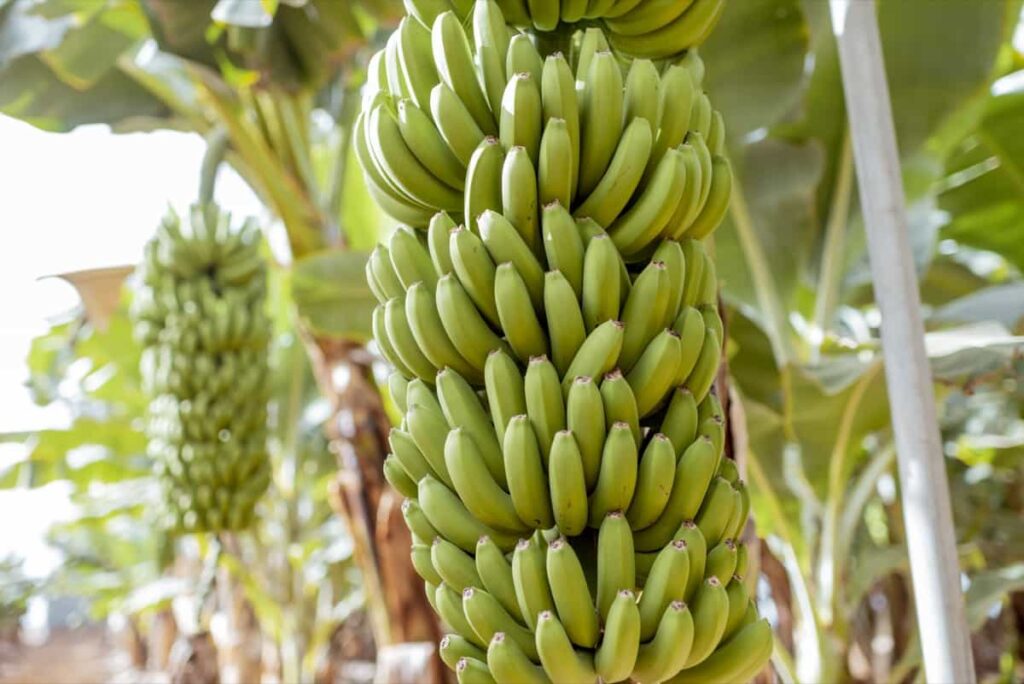
The country’s strategic location, efficient logistics, and quality products drive its competitive edge. Investments in sustainable practices and disease control enhance export potential, presenting ample growth opportunities in the global banana market.
Economic Analysis and Financial Considerations for Cavendish Banana Farming
The Cavendish banana industry was the leading agricultural activity in the Philippines, contributing significantly to the country’s economy. According to the Philippine Statistics Authority (PSA), the industry generated an output value of P46.51 billion, accounting for 29.5% of the total output from agriculture, forestry, and fishing establishments, which amounted to P156.5 billion.
Despite having only 6.7% of the total establishments in the sector, the banana industry employed 29.7% of the sector’s workforce (48,442 workers) and provided the highest average annual compensation of P11.2 billion. Additionally, the Cavendish banana industry held the highest value-added percentage at 35.6% among agri-related industries, contributing to a total value added of P14.4 billion. The industry’s remarkable performance significantly impacted the Philippines’ economic and employment landscapes that year.
Sustainable Practices in Cavendish Banana Farming in the Philippines
Sustainable practices in Cavendish banana farming in the Philippines encompass every stage, from land preparation to harvesting. Farmers prioritize organic matter incorporation and minimal soil disturbance, starting with land preparation. Spacing is maintained at 2.5 to 3 meters between rows and 2.5 meters within rows, ensuring proper airflow and sunlight.
Planting holes are enriched with organic materials and fertilizers to enhance soil health. Young plants, aged 8-10 months, are transplanted, avoiding waterlogged conditions during planting. Trimming of roots and pseudostems minimizes transplant shock. Throughout growth, sustainable water management is crucial. Efficient irrigation and mulching retain soil moisture and control weeds.
Integrated Pest Management (IPM) techniques are employed to reduce chemical use. Beneficial insects and disease-resistant varieties are introduced, and monitoring ensures timely interventions. To promote soil health, cover cropping, and crop rotation are practiced. Balanced fertilizers are applied potassium to improve fruit quality. Composting and vermiculture further enhance soil structure and nutrient content. Efficient nutrient and water management reduce leaching and runoff, minimizing environmental impact.
During fruit development, ethical labor practices are maintained. Protective equipment is provided, and workers know about safety measures and proper chemical handling. Harvesting occurs when the bananas are mature and adequately sized, following global quality standards. Post-harvest, sustainable practices continue with proper waste management. Unusable plant parts are composted or recycled. Farmers are encouraged to engage in fair trade and sustainable certification programs, enhancing market access and supporting livelihoods.
Challenges and Future Prospects of Cavendish Banana Farming in the Philippines
Cavendish banana farming in the Philippines faces challenges like disease outbreaks (e.g., Fusarium wilt), market fluctuations, and environmental concerns. The overreliance on a single variety makes the industry vulnerable to diseases. Climate change and water scarcity impact cultivation.
In case you missed it: High Yield Hybrid Banana Varieties in India: State Wise Guide

However, prospects involve adopting disease-resistant varieties, implementing sustainable practices, and diversifying exports. Strengthening research, innovation, and international partnerships can address challenges while promoting a resilient and competitive banana industry, ensuring the Philippines’ economic stability and environmental sustainability.
Conclusion
In the Philippines, Cavendish banana production thrives through meticulous farming practices. From nutrient management to disease control, farmers adhere to sustainable approaches. With extensive export opportunities and a significant global market share, the nation’s dedication to quality and innovation ensures a promising future for the Cavendish banana industry.
- Broccoli Varieties: Choosing the Right Cultivars for Your Farm
- How to Raise Pigs in Your Own Backyard: A Comprehensive Guide
- Budget Friendly Sheep Shed Ideas: Cheap and Low-Cost Tips
- How Much Do Cattle Farmers Make: Revenue Streams in Cattle Farming
- Management Pests and Diseases in Your Cotton Field
- Sheep Farming Business Plan for Beginners
- Aquaponic Farming at Home: A Step-By-Step Guide
- Profitable Village Farming Business Ideas in 2024
- High-Yield Aquaculture: Fast-Growing Fish for Farming
- Effective Fish Pond Construction Techniques for Beginners
- Irrigation and Water Management in Pineapple Farming
- Blossom to Harvest: Mastering Flowering and Pollination in Papaya Farming
- Pig Fattening Essentials: From Selection to Sale for Beginners
- Raising Wagyu Cattle: A Complete Guide for Premium Beef Production
- Soil Types and Their Water Holding Capacity
- Optimizing Irrigation Schedules for Coconut Groves for Enhanced Yield
- Espresso Your Garden: Coffee Grounds for Healthier Acid-Loving Plants
- The Best Soil Mix for Snake Plants: How to Mix Your Own Snake Plant Soil
- Green Thumb Success: Expert Tips for Cultivating Greenhouse Beans All Year Round
- Bloom All Year Round: The Ultimate Guide to Indoor Hyacinth Care
- Eco-Friendly Gardening: How to Make Liquid Fertilizer from Kitchen Waste
- Ultimate Guide to Grow Anise in Pots: Explore Seed Propagation to Harvesting
- Guide to Raising Chester White Pigs: Discover Breed Facts to Growth Management
- Mastering the Elegance: The Ultimate Guide to Weeping Cherry Tree Care, Planting, and Maintenance
- Ultimate Guide to Planting Garlic in Grow Bags: Growing Strategies for Beginners
- How to Fix Spider Plant Leaf-Related Problems: Natural and Organic Remedies
- 10 Reasons Why Your Tulsi Plant is Shedding Leaves: Home Remedies and Solutions
- Optimizing Growth and Yield: The Advantages of Palm Bunch Ash Fertilizer
- Utilizing Neem Oil Extract as a Natural Pesticide for Hydrangea
- From Soil to Harvest: Various Ways in Which Farmers Can Use AI Tools
- Steps to Encourage and Induce Citrus Flowers: A Comprehensive Guide
- How to Fix Snake Plant Leaf-Related Issues: Natural and Organic Remedies
- Transform Your Garden into a Fragrant Oasis with Raat Ki Rani (Night Blooming Jasmine)
- Discover the Ideal Chicken Breeds for Philippine Farms
- How to Create a Poultry Egg Farm Business Plan for Profits
- Grow Lemon Cucumbers Like a Pro: Insider Techniques for Bountiful Yields
